Mercy G. Ajuru 1, Bosa E. Okoli 2
1Department of Biology, Ignatius Ajuru University of Education, P.M.B. 5047, Port Harcourt, Rivers State, Nigeria
2Department of Plant Science and Biotechnology, University of Port Harcourt, P.M.B. 5323, Port Harcourt, Rivers State. Nigeria
Correspondence to: Mercy G. Ajuru , Department of Biology, Ignatius Ajuru University of Education, P.M.B. 5047, Port Harcourt, Rivers State, Nigeria.
| Email: |  |
Copyright © 2012 Scientific & Academic Publishing. All Rights Reserved.
Abstract
A comparative study of the morphological and foliar epidermal characteristics of three species of Napoleona Beauv., N. imperialis P. Beauv., N. vogelli Hook. and Planch and N. gossweileri Baker f. was carried out by simple light microscopy. While N. imperialis and N. vogelli are shrubs, with the bark, smooth, shallow and fibrous, N. gossweileri is a woody climbing liane, with thick-barked stem. Significant variations in leaf size, flower colour, fruit shape and colour when ripe and stomatal type which could be exploited for taxonomic purposes were observed among the species. The study aims at contributing morphological and epidermal information on the scanty literature available on the species which have potentials for medicinal, ornamental and food purposes.
Keywords:
Epidermal Characteristics, Lecythidaceae, Morphology, Napoleona
Cite this paper:
Mercy G. Ajuru , Bosa E. Okoli , "Morphological and Epidermal Studies on Certain Species of Napoleona P. Beauv. (Lecythidaceae) in Nigeria", International Journal of Modern Botany, Vol. 2 No. 4, 2012, pp. 115-119. doi: 10.5923/j.ijmb.20120204.09.
1. Introduction
The family, Lecythidaceae is a small tropical family that grows in all regions of Nigeria[1]. The plant, Napoleona, is commonly known as nkpodu among the Igbo tribe of Nigeria. The sweet pulp around the seeds is eaten especially by children. The genus, named in honour of Emperor Napoleon 1 comprises mostly shrubs with some species being lianes[1]. The leaves are completely glabrous, entire, acuminate with a cuneate base. The leaf margins have distinctive shallow glands at irregular intervals, but this character is rather variable and in some species, the glands are confined to the leaf base[2]. The flowers are multi-coloured and often conspicuous. Petals are united into a disc and measure up to 5cm in diameter with ragged edges, two rows of staminodes, the outer row composed of many narrow, almost thread-like teeth spread out flat, the inner forming a cup with upright petaloid teeth. The fruits are crowned by the persistent calyx, deeply lobed and more or less globose, yellowish or reddish when ripe and slightly warted. There are several large seeds shaped like the segments of an orange and surrounded by a gelatinous pulp[2].The three species of Napoleona studied, N. imperialis P. Beauv., N. vogelli Hook. & Planch and N. gossweileri Baker f. are economically important. They are significant as medicinal plants and sources of food but no detailed comparative work on these species has been done to date. This paper forms part of a research carried out on various aspects of the biosystematics of the genus aimed at providing basic morphological and micro-morphological data on these species for taxonomic and breeding purposes.
2. Materials and Methods
Studies were made on living plant materials collected during field trips to various parts of Nigeria. Materials from plants raised from seeds and cuttings nurtured in the University of Port Harcourt Botanical Garden were also used. Morphological studies were made from observations of live specimens and quantitative measurements of vegetative and floral parts were taken. For epidermal studies, the middle portion of some of the fresh leaves obtained were cut out and soaked overnight in sodium hypochlorite. The material was then carefully picked from the container using fine forceps and placed in a watch-glass containing distilled water. The material was rinsed in three changes of distilled water and adhering cells on the epidermis were dusted off using carmel hair brush. The strip of epidermis required was stained in 1% safranin and mounted in glycerine. Photographs of good preparations were taken using a Leitz Diaplan photomicroscope fitted with Leica WILD MPS 52 camera. Voucher specimens were deposited in the University of Port Harcourt Herbarium.
3. Results
3.1. Morphological Characters
The habit, vegetative and floral morphology of the three species of Napoleona P. Beauv. studied is summarized in Table 1 and shown in Figures 1- 6. N. imperialis thrives on the under-storey of forest, thus, it is often found in abundance in the forest, especially in a primary forest. It is a shrub of about 6m high. The leaves are large, reaching 27–30 ± 1.5cm in length and 8–11.5 ± 0.8cm in width; glabrous, oblong-elliptic, simple, entire, elongated, abruptly acuminate, rounded at the base, glossy, “Figure 1”. The glands at the base of the acumen conspicuously stand out as small teeth . The petiole is 1.0cm – 1.2 ± 1.0 cm long and 0.2 – 0.4 ± 0.3 cm wide. The bark of the stem is grey, smooth, slash whitish, shallow and fibrous. Branches are whorled. The showy flowers often occur on the main branches and trunk as well as among leaves. They are solitary, 4.5 – 5.0 ± 0.5 cm long and 5.0 – 5.5 ± 0.6cm wide. The flowers are variable in colour, petals are cream–yellow with purple lines, dark red at the base, white staminodes with leathery calyx, valvate, glabrous, with about five triangular teeth. The stigma is pink; the calyx tube is 4.0–5.0 ± 0.5cm long. The fruit is brown with white spots, flattened globose with a depressed centre, 4.0–4.5 ± 0.5cm in diameter, a berry, woody and fleshy, Figure 2”. The seeds are brownish in colour, 5 – 10 in number, embedded in the fruit pulp, 1.5 ± 0.2cm by 1.0 ± 0.1cm wide. The seed mucilage is intensely sweet to taste and edible.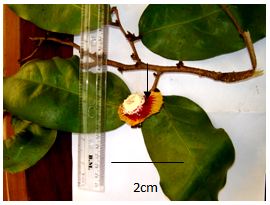 | Figure 1. Vegetative and Floral macro-morphological features of N. imperialis, Arrow shows open flower at maturity |
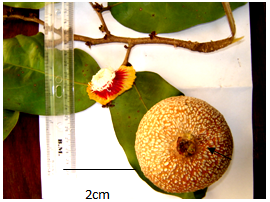 | Figure 2. N. imperialis showing the mature fruit |
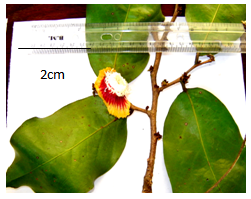 | Figure 3. Leaves and flower of N. vogelli |
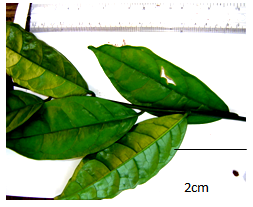 | Figure 4. Leaves of N. gossweileri |
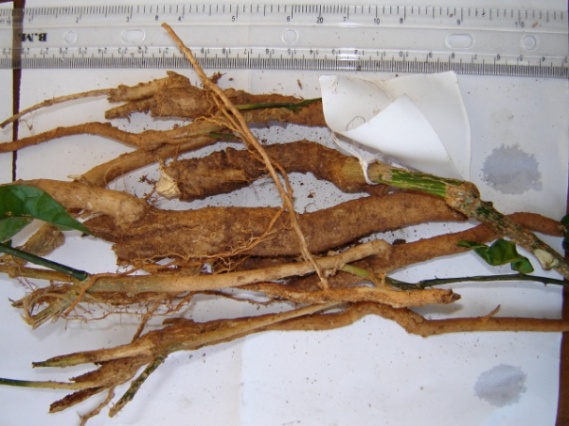 | Figure 5. Roots of N. gossweileri |
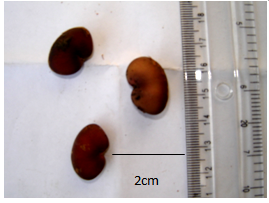 | Figure 6. Seeds of Napoleona species |
N. vogelli is a water-loving plant. Thus, it is often found in abundance by streams and close to the seashore[3]. It is a shrub of about 6m high. The leaves are shortly acuminate, oblong - elliptic, shortly cuneate at the base, 13.0 – 15.0 ± 1.2cm long, 5.0 – 7.5 ± 0.5cm wide, glabrous, closely reticulate beneath, lateral nerves ascending within the margin, “Figure 3”. The petiole is 0.6 – 0.8 ± 0.4cm long and 0.1 ± 0.01cm wide . Flowers are solitary, 4.0 – 4.5 ± 0.5 cm long and 4.5 – 5 ± 0.6cm wide and brilliantly attractive. The fused petals are cream-yellow at the apex and dark-red at the apex with two whorls of staminodes forming a floral crown with leathery calyx, glabrous, with about five triangular teeth of. The calyx is 3.5 – 4.0 ± 0.4cm long and five in number. The flower is bisexual. The fruit of N. vogelli is a berry, orange brown with white spots, sub globose with a depressed base, and 3.0–4.0 ± 0.3cm in diameter. The five – twelve seeds are surrounded by a sweet, edible pulp.N. gossweileri is a woody climbing liana, rhizomatous, up to 14.0 ± 1.1m high, with several shoots from the base, forming dense colonies in woodland. The root is soft wooded with thick bark. It is used to cure fevers and arrow poisons are reportedly produced from the bark[4]. The stem slash and roots have strong pungent smell. The leaves are acuminate, simple, elliptic, cuneate at the base, 7.5–14.0 ± 1.0cm long and 2.5 – 5.5 ± 0.6cm wide, glabrous, lateral nerves ascending within the margin, “Figures 4 & 5”. The petiole is 0.6 – 0.8 ± 0.4cm long and 0.1 ± 0.01cm wide . The flowers are solitary, 4.0–4.5 ± 0.7cm long and 4.5 – 5.0 ± 0.8cm wide, cream - yellow at the apex, purple at the base, white to milky staminodes with leathery calyx, which is 5 in number and free. Calyx tube is 4.0 – 4.5 ± 0.5cm long. Flowers are bisexual with sweet scent. The fruit is a red berry and conically shaped and 3.5 – 4.0 ± 0.2cm long and 4.0 ± 0.2cm wide. When ripe, it is reddish in colour but covered by grayish – green scales on the surface. It is warty, irregular, globose and many-seeded. The seeds are three – eight in number and are embedded in the fruit pulp. They are 1.5 ± 0.2cm by 1 ± 0.1cm in size, and covered by mucilage which is intensely sweet to taste. The seed kernel is slightly sweet to taste, “Figure 6”.| Table 1. Vegetative and Floral Characteristicsof Napoleona Species |
| | Character | N. imperialis | N. vogelli | N. gossweileri | | Plant duration | Perennial | Perennial | Perennial | | Habit | Shrub | Shrub | Lianes | | Stem | Branched low down | Branched low down | Rhizomatous | | Bark colour | Grey and slashed white | Grey and slashed white | Grey and slashed white | | Leaf type | Simple | Simple | Simple | | Leaf form | Broadly elliptic | Broadly elliptic | Elliptic | | Leaf apex | Acuminate | Acuminate | Acuminate | | Leaf base | Cuneate | Cuneate | Cuneate | | Leaf arrangement | Alternate | Alternate | Alternate | | Leaf surface | Glabrous | Glabrous | Glabrous | | Leaf venation | Reticulate | Reticulate | Reticulate | | Petiole | Present | Present | Present | | Inflorescence | Usually solitary | Usually solitary | Solitary | | Inflorescence position | Axillary | Axillary | Axillary | | Flower colour | Cream-yellow at the apex with purple lines, dark red at the base | Cream - Yellow at the apex, dark red at the base | Cream - yellow at the apex, purple at the base | | Position of ovary | Inferior | Inferior | Inferior | | Sexuality of flower | Bisexual | Bisexual | Bisexual | | Flower size | 4.5 – 5.0 ± 0.5cm long and 5–5.5±0.6cm wide | 4.0–4.5±0.5cm long and4.5–5.0±0.6cm wide | 4.0–4.5±0.7cm long and 4.5– 5.0±0.8cm wide | | Fruiting period | April – June | May – July | Dec. – Feb. | | Aestivation | Imbricate | Imbricate | Imbricate | | Fruit colour | Brownish with white spots | Orange brown with white spots | Reddish but covered with grayish – green scales | | Fruit size | 4.0–4.5±0.5cm in diameter | 3.0–4.0±0.3cm in diameter | 3.5–4.0±0.2cm in diameter | | Androecium type | Basifixed | Basifixed | Basifixed | | Placentation type | Axillary | Axillary | Axillary | | Fruit type | Berry | Berry | Berry | | Seed size | 1.5±0.2cm by 1.0±0.1 cm wide | 1.5±0.2cm by 1.0±0.1 cm wide | 1.5±0.2cm by 1.0±0.1cm wide |
|
|
Table 2. Epidermal Cell Characteristics of the Napoleona Species Studied
 |
| |
|
3.2. Micro–morphological Characters
The epidermal cell shape is wavy / irregular in both surfaces of N. gossweileri and N. vogelli, “Figures 7-10” but highly irregular in N. imperialis, “Figures 11&12”. The anticlinal wall is sinuous on the adaxial surfaces of the three species but quite significantly so on both the abaxial and adaxial surfaces of N. imperialis. The distribution of stomata is hypostomatic in the three species. The stomatal type in N. imperialis and N. gossweileri is anisocytic. N. vogellii has anomocytic stomata. The guard cells in N. imperialis and N. vogelli are raised while in N. gossweileri, the guard cells are on the same level with the adjacent epidermal cells. In general, the stomata are longer than they are wide in all the collections studied.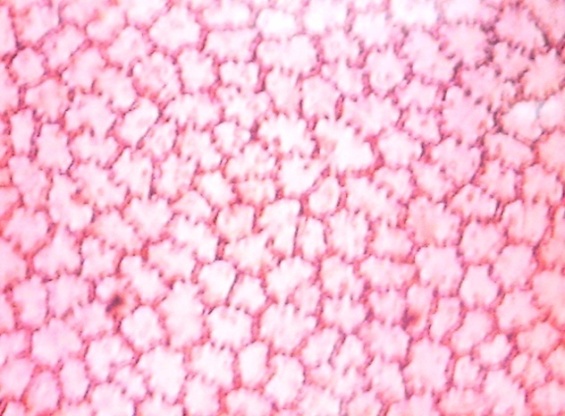 | Figure 7. Adaxial epidermis of N. gossweileri showing sinuous anticlinal walls |
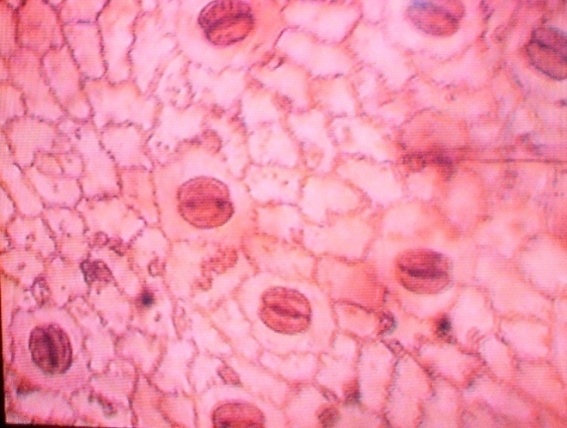 | Figure 8. Abaxial epidermis of N. gossweileri showing anisocytic stomata |
 | Figure 9. Adaxial epidermis of N. vogelli |
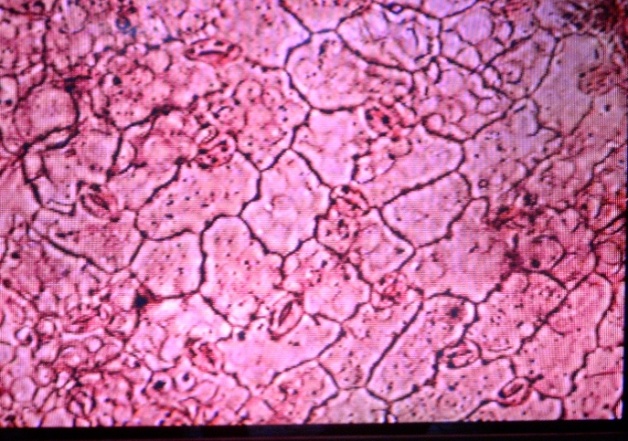 | Figure 10. Abaxial epidermis of N. vogelli showing anomocytic stomata |
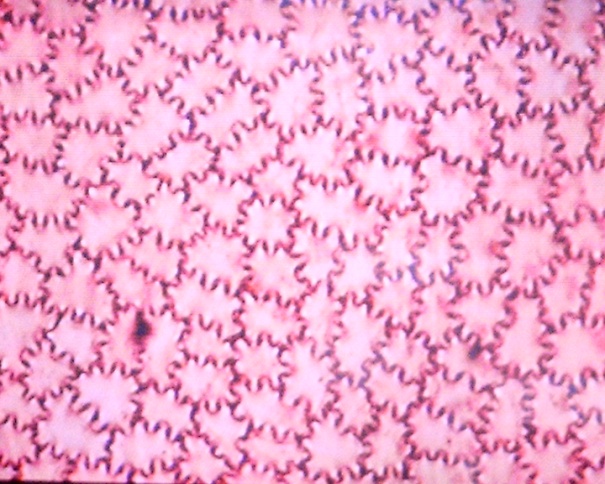 | Figure 11. Adaxial epidermis of N. imperialis showing sinuous anticlinal walls |
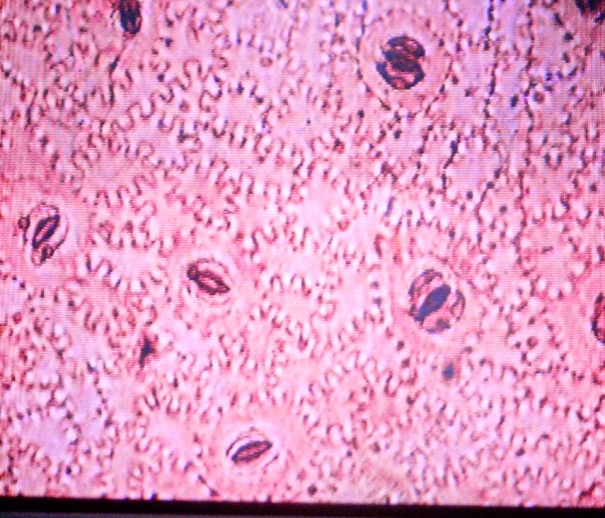 | Figure 12. Abaxial epidermis of N. imperialis showing anisocytic stomata and highly sinuous anticlinal walls |
4. Discussion
Our observations indicate that there are no significant morphological differences between N. imperialis and N. vogelli even though N. imperialis has longer and wider leaves than N. vogelli. This may be due to environmental effect on the plants. The two species in general have similar epidermal features. Differences observed have to do with the degree of waviness of the epidermal cells and in N. imperialis possessing anisocytic stomata while the stomatal type in N. vogelli is anomocytic. The closeness in character is so much that the two species may now be considered as constituting a Napoleona imperialis–vogelli complex. More studies involving, for example, cytogenetics and phytochemistry would, however, throw more light on their precise relationship. In contrast, the variation between them and N. gossweileri is big. In the first place, N. gossweileri is a liane while N. imperialis and N. vogelli are shrubs. The morphological differences between N. gossweileri on one hand and N. imperialis and N. vogelli on the other hand are thus significant enough to warrant their being considered distinct species. This position is further buttressed by the significant differences in their stomatal indices as shown in Table 1. The importance of stomatal index in delimiting species within a genus had been highlighted by[5] as well by[6] in their study of the genus Abrus and[7] on Telfairia.The marked absence of trichomes, both covering and glandular types on leaves of all three species must be considered not only diagnostic but also of ecological significance. It is hardly surprising though since they are found nearly exclusively in the rain forest regions of the country.Further studies on these little known species with a view to optimally exploiting their medicinal, ornamental and nutritive potentials are highly recommended.
5. Conclusions
The closeness in character between N. imperialis and N. vogelli is so much that the two species may now be named Napoleona imperialis-vogelli complex. Furtherinvestigations especially in cytogenetics and phytochemistry may provide relevant information to authenticate the classification of these species.
ACKNOWLEDGEMENTS
The authors wish to acknowledge the Curator of the University of Port Harcourt Herbarium for his help in the identification of some of the collections.
References
| [1] | Hutchinson, J. and J.M. Dalziel, Flora of West Tropical Africa, 2nd Edition, Crown Agents for Overseas Government and Administrations, Millbank, London, 241-245, 1963. |
| [2] | Hutchinson, J. and J.M. Dalziel. Flora of West Tropical Africa, 1st Edition, Crown Agents for Overseas Government and Administrations, Millbank, London 180–184, 1958. |
| [3] | Keay, R.W.J. Trees of Nigeria, Oxford Science Publications, New York, 78-81. 1989. |
| [4] | Burkill, H.M. . The useful plants of West Tropical Africa, Vol. 1, A – D, Royal Botanic Gardens, Kew. 1985 |
| [5] | Carlquist, S. Comparative Plant Anatomy. Holt, Rinehart and Winston, New York and London. 1961. |
| [6] | Agbagwa, I.O. and B.E. Okoli, “Leaf epidermal micromorphology in the systematics of Abrus Adanson (Papilionaceae) in parts of tropical West Africa”, Asian Journal of Plant Science, vol.5: pp. 41-49, 2006. |
| [7] | Okoli, B.E. “Anatomical studies in the leaf and probract of Telfairia Hooker (Cucurbitaceae)” Feddes Repertorium 98 (3-4): 231-236, 1987. |













 Abstract
Abstract Reference
Reference Full-Text PDF
Full-Text PDF Full-Text HTML
Full-Text HTML